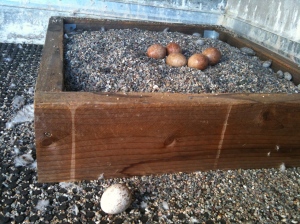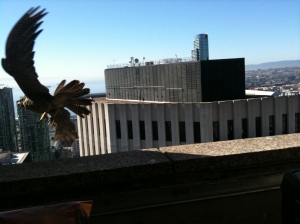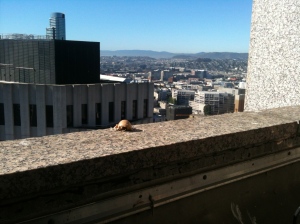 I approached this nest with permission of the US Fish and Wildlife Service one week after Summer Solstice for the purpose of collecting addled eggs for contaminent analysis. The photo above shows the status of the nest on June 28th 2013. Five eggs remained in the scrape. One intact egg lay beside the nest box. And a seventh egg was found broken on the ledge nearby.
I approached this nest with permission of the US Fish and Wildlife Service one week after Summer Solstice for the purpose of collecting addled eggs for contaminent analysis. The photo above shows the status of the nest on June 28th 2013. Five eggs remained in the scrape. One intact egg lay beside the nest box. And a seventh egg was found broken on the ledge nearby.
The broken egg contained a mostly developed embryo that must have died during the period when Dan had the entire burden of incubation but left the scrape at least once per day to feed himself. It is the best evidence we have right now that Lil’s eggs were viable but did not hatch because of incomplete incubation. It is likely that Cher’s eggs were not fertile.
When we reached the balcony on the 33rd floor of the PG&E headquarters building at 77 Beale Street, Cher was incubating the clutch of five eggs. She got up, cacked at us, and then left the nest box but flew past the balcony repeatedly cacking and even perched several times on the ledge to voice her displeasure with our intrusion. Here is a picture of her jumping into flight when I aimed my iPhone at her to snap a photo. (I know, I should have brought Glenn Nevill along for better photos).
Disruption of the nest cycle by a new female was disconcerting for nest
camera viewers but is something we should prepare ourselves to see more of
in the coming years. It is evidence of a robust recovered peregrine falcon
population in the San Francisco Bay Area, and across California.
Non-breeding members of the peregrine falcon population, or “floaters,” are
searching for nesting territories. Some are challenging territory owners,
as Cher did, for the opportunity to breed. While we become attached to
individual falcons, we need to remember that fitness to breed is
fundamental to the viability of species. Hard as it may have been to watch,
we witnessed first-hand the selection of the most fit breeders playing out
this year at PG&E. Last year, we saw it happen at San Jose City Hall when
Fernando replaced EC.
One final note… I have often repeated our belief that peregrines know how
long incubation should take and quit when that period expires. When the
Predatory Bird Research Group and others worked to recover the peregrine
falcon population, our work was rigorous. There was rigorous attention to
the husbandry of captive falcons and rigorous attention to the known
timelines of nesting chronology. We knew that incubation was a thirty-three
day period so we always returned to nests where we left dummy eggs (so that
we could hatch the real ones in our incubators) within the 33 day
incubation cycle to foster young. Nest cameras around the world are now
recording the long incubation times of peregrines that far exceed required
incubation periods. It turns out that we did not fully appreciate the
tenacity of the peregrine to defend its nest territory and to incubate eggs
that were long overdue.
These observations bring me once again to a sense of awe for a bird that
hurtles from the sky each day–at hundreds of miles per hour–to crash into
other birds in order to acquire a meal to eat… It is a bird that almost
succumbed to the effects of toxic chemicals that we added to the
environment just a half century ago. A humbling realization.
